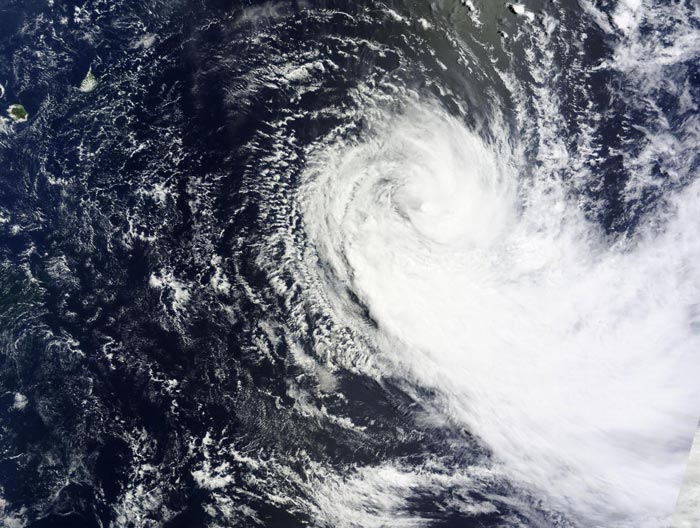NASA's Terra satellite sees Tropical Cyclone Glenda stretching out

NASA's Terra satellite captured a visible image of Glenda on Feb. 27 that revealed the bulk of storm's clouds pushed southeast of the center. Credit: NASA Goddard MODIS Rapid Response Team
When Terra passed over the Southern Indian Ocean on Feb. 27, the Moderate Resolution Imaging Spectroradiometer (MODIS) instrument captured a visible image of the storm.
In the image, the bulk of clouds associated with the storm appeared to be pushed southeast of the center and away from the islands of Mauritius and La Reunion.
The Joint Typhoon Warning Center (JTWC) noted today, Feb. 27, “animated multispectral satellite imagery shows the system has begun to show signs of elongation as the main convective bands are displaced eastward of a partially-exposed low-level circulation center.”
At 0900 UTC (4 a.m. EST), Glenda's maximum sustained winds had dropped to near 45 knots (51.7 mph/83.3 kph). Glenda was centered near 22.4 south latitude and 67.2 east longitude, about 573 nautical miles (659.4 miles/1,061 km) east-southeast of Port Louis, Mauritius. Glenda was moving to the south at 7 knots (8 mph/12.9 kph).
JTWC reported in their upper-level atmosphere analysis that Glenda is located in a “marginal environment with moderate vertical wind shear offset by excellent poleward outflow.”
By Saturday, Feb. 28, Glenda is expected to transition to an extra-tropical storm and become a cold-core system.
Media Contact
All latest news from the category: Earth Sciences
Earth Sciences (also referred to as Geosciences), which deals with basic issues surrounding our planet, plays a vital role in the area of energy and raw materials supply.
Earth Sciences comprises subjects such as geology, geography, geological informatics, paleontology, mineralogy, petrography, crystallography, geophysics, geodesy, glaciology, cartography, photogrammetry, meteorology and seismology, early-warning systems, earthquake research and polar research.
Newest articles

Red light therapy for repairing spinal cord injury passes milestone
Patients with spinal cord injury (SCI) could benefit from a future treatment to repair nerve connections using red and near-infrared light. The method, invented by scientists at the University of…

Insect research is revolutionized by technology
New technologies can revolutionise insect research and environmental monitoring. By using DNA, images, sounds and flight patterns analysed by AI, it’s possible to gain new insights into the world of…

X-ray satellite XMM-newton sees ‘space clover’ in a new light
Astronomers have discovered enormous circular radio features of unknown origin around some galaxies. Now, new observations of one dubbed the Cloverleaf suggest it was created by clashing groups of galaxies….





















